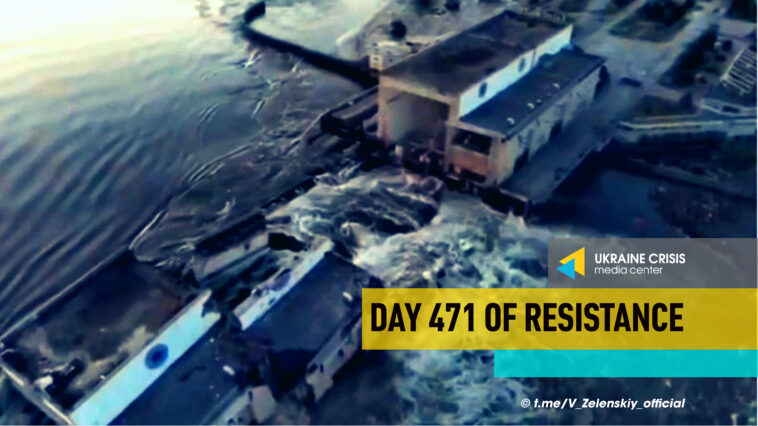Evidence is growing that the Kakhovka hydropower plant was blown up. Russia launches a barrage of missiles and drones overnight at Ukraine.
Evidence growing that Kakhovka hydropower plant was blown up
Conversations between Russian soldiers intercepted by Ukraine’s security service prove Russia’s involvement. On June 9, the Ukrainian Security Service published an intercepted phone call between two Russian soldiers, proving Russian responsibility for blowing up the Kakhovka hydroelectric power plant. The tapped phone call shows that the Russians wanted to blackmail or cause fear in Ukraine by blowing up the dam, but likely miscalculated the scale of explosion, causing a man-made disaster in southern Ukraine.
“So our guys [the Russians] did it,” one of the men says, denying assumptions by the other speaker that the destruction was carried out by the Ukrainians. “It’s not them, it’s ours,” he said.
“Really, it was ours? They said that the [Ukrainians] struck it,” the other Russian said in surprise.
“They [the Ukrainians] didn’t strike it. That was our sabotage group. They wanted to cause fear with this dam. It did not go according to the plan. More than they [the Russians] planned,” the speaker said.
Seismic stations detect explosion at dam. In the early hours of June 6, when the Kakhovka hydroelectric power plant and dam collapsed, regional seismic stations recorded the data showing there was a powerful blast at the site.
Norsar (the Norwegian Seismic Array), a Norwegian group that monitors seismic networks throughout Europe, said signals from a regional station in Romania (Bucovina Seismic Array) pointed to an explosion at 2.54 a.m. The seismic signal was detected in Romania, 620 kilometers from the dam of the Kakhovka hydroelectric power plant.
Norsar was established in 1968 as part of the Norwegian-U.S. agreement for the detection of earthquakes and nuclear explosions.
Russia launches missiles, drones overnight at Ukraine
Overnight on June 9, Russia launched six cruise missiles and 16 attack drones into Ukraine. Ukrainian air defenses destroyed four missiles and 10 drones.
Russia continues to terrorize Ukraine with air strikes, trying to sow panic and searching for weak points in Ukrainian air defenses.
Spokesperson for the Ukrainian Air Force Command Colonel Yuriy Ihnat said on television: “This time, [Russia] launched its kamikaze drones, surveillance drones, and missiles that were flying in circles. They were programmed in a way to fly circles around the cities.”
“What is their goal? To sow panic, which I don’t even mention, that’s what they permanently do, and in general to disperse capabilities of the air defenses and identify their weak points. [Russia] uses Shahed drones to deplete ammunition stocks and find weak points in our air defenses.”
“They also want to mislead us with missiles. They are launched in a certain direction, then they change it and make circles as they fly. We destroyed them where possible.”
“Four of six Kh-101/Kh-55 air-launched cruise missiles were destroyed today.”
Ihnat also said that Kh-55 missiles are capable of carrying a nuclear warhead. Russia has been frequently firing them without their nuclear warheads to deplete Ukrainian air defenses.
Russia’s role in Nagorno-Karabakh conflict. Ukraine in Flames #456
Nagorno-Karabakh is the first military conflict in the post-Soviet space, which gave rise to others as well, with russia actively using the confrontation between Armenia and Azerbaijan to advance its interests in the South Caucasus. It was with the Kremlin’s support that defensive fortifications were built in Nagorno-Karabakh, which prevented Azerbaijan from quickly gaining control over the territory. In addition, the russian military base, located on the territory of Armenia, was an outpost of the russian federation for use in hybrid conflicts like the one in Karabakh. Watch Ukraine in flames #456 to find out about the complexities of russia’s role in the Nagorno-Karabakh conflict and examine the historical, political, and strategic factors that have shaped the geopolitical map of the region.
Guests:
- Murad Muradov, Co-founder and Deputy Director of the Topchubashov Center
- Rusif Huseynov, Co-Founder and Director of the Topchubashov Center
- Kanan Jafarov, Energy Expert, specializing in the trade and the energy
- Maryna Goncharuk, Journalist, Curator of Ukrainian-Turkic cultural projects




